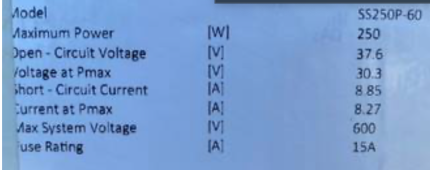OK, I'm confused. The addreviations don't help.
Sorry, these are all from your pic in post #7. Unfortunately they are not labeled with abbreviations.

There are 2 panel voltages. One is the open circuit voltage (Voc) and this is the no-load voltage that a panel will achieve under the specified test conditions at 25C. This is the equivalent of revving your car while in neutral. This voltage is used for configuring the array and making sure it does not exceed your SCCs max input voltage.
The second voltage is max power voltage (Vmp) and its pretty much the expected working voltage. This voltage (along with Imp) is used in calculating panel watts (more on that later).
There are 2 panel amperages. One is the "worst case" short circuit amperage used for sizing panel/array wiring and fusing. It can be measured easiest with a clamp meter with the panels + and - wires connected. It sounds bad but its ok for short periods of testing.
The second amperage is max power current (Imp, "I" ... capital i, is the symbol for current). Imp is the working current in amps, or commonly just called amps.
So to get back to your question in post, you use the Vmp value (the sum for each 3 panels in series) and Imp value (the sum for each of the 3 strings connected in parallel)
By my calculations, 112.8 volts and 24.81 amps = 2798.57 watts, Correct??
Each panel: 30.3Vmp x 8.27Imp = 250.5W
(3 x 30.3V) x (3 x 8.27) = 2255W
Hopefully this makes sense and is helpful. Please ask if its not clear.
One thing is should add is that when you have 3 or more strings connected in parallel, each string needs to be fused. So you will need 3 of these MC4 fuses to add to the + lines to your panels at the 3:1 Y connector.



